Study Guide
Field 024: Integrated Science
Sample Multiple-Choice Questions
The following reference material will be available to you during the assessment:
Competency 0001
Understand principles and procedures of scientific inquiry.
A researcher wants to experimentally evaluate the effectiveness of three different types of insulation. The researcher completely wraps three identical glass containers in 1-cm-thick pieces of each type of insulation. The researcher fills the containers with water at 100°C and then quickly seals them. After 15 minutes, the containers are opened and the temperature of the water in each container is measured. The same experiment is then repeated two more times with the same apparatus. The results of the three separate trials are then averaged. Which of the following changes to the experimental design would make this a better experiment?
- carrying out an additional trial that uses ice cubes to measure how long it takes the ice cubes to fully melt in the three different types of insulated containers
- measuring the temperature of the water in the three containers at several different time intervals to create a heat-loss curve for each material
- setting up a control in each trial to measure the change in temperature in a matching glass container without any added insulation
- increasing the thickness of the insulation used in order to more clearly distinguish the insulating properties of each of the materials
- Answer
-
Correct Response: C.
This question requires the examinee to demonstrate knowledge of the principles and procedures for designing and carrying out scientific investigations. To improve the experimental design the researcher should test the insulating capacity of a matching glass container that has no insulation as part of each trial. The use of a control establishes a baseline against which the various insulating materials can be compared when analyzing the results.
Competency 0002
Understand the history and nature of science.
Lynn Margulis is a U.S. biologist whose contribution to the understanding of the evolution of the eukaryotic cell was groundbreaking. Although originally rejected repeatedly by mainstream biologists, her theory on the evolution of the eukaryotic cell is now widely accepted. Margulis's work has helped establish that chloroplasts and mitochondria in eukaryotic cells originally developed as a result of:
- the incorporation of free-living prokaryotes into other prokaryotic cells.
- the merging of two varieties of eukaryotic cell into a single-celled organism.
- the incorporation of nonpathogenic viral DNA into a primitive eukaryotic cell.
- the mutation of RNA in ancient prokaryotes that led to more efficient energy use.
- Answer
-
Correct Response: A.
This question requires the examinee to demonstrate knowledge of the historical development of major scientific ideas, including contributions by men and women of diverse backgrounds. Lynn Margulis's original paper on the evolution of the eukaryotic cell and her work on endosymbiotic theory established that certain cell organelles (e.g., mitochondria, chloroplast) originated as free-living bacteria that moved into other prokaryotic cells, eventually evolving into eukaryotic cells over millions of years. Her persistence in arguing in support of the theory of endosymbiosis, even though it was strongly criticized by the mainstream biological community, demonstrates the importance of tenacity in putting forward new scientific ideas.
Competency 0003
Understand the relationships between science, technology, engineering, mathematics,
and society.
In a number of well-publicized cases, some of the most important and reputable scientific journals have had to retract published research papers because the research proved to be fraudulent. Which of the following strategies would most improve the system used by these journals for identifying fraudulent research papers before they are published?
- verifying that the data and methodologies described in research papers are legitimate
- giving priority to scientists who have previously submitted legitimate research papers
- releasing data and findings presented in research papers directly to the general public
- having scientists from outside the field review research papers when they are submitted
- Answer
-
Correct Response: A.
This question requires the examinee to analyze social, economic, and ethical issues associated with technological and scientific developments. Prior to publication in a professional scientific journal, research papers are typically reviewed by scientists with similar professional backgrounds and knowledge of the research subject. Although the system usually works well, the complexity of some research makes peer review of submitted papers a costly and time-consuming process. Since appropriate methodology and accurate data are underpinnings of legitimate scientific research, further scrutiny of these two areas provides the best method for reducing the publication of fraudulent research papers.
Competency 0004
Understand the properties and characteristics of matter.
Dissolving table salt in water elevates the boiling point of the salt solution. This colligative property of the salt solution is most directly affected by which of the following factors?
- the reactivity of sodium and chloride ions
- the concentration of the solute dissolved in the solution
- the specific heat capacity of the solution
- the reduced hydrogen bonding between water molecules
- Answer
-
Correct Response: B.
This question requires the examinee to analyze the colligative properties of solutions (e.g., freezing point, boiling point, osmotic pressure, vapor pressure). Colligative properties, such as the boiling point and freezing point of a substance, have been shown experimentally to be influenced by the number of particles present in the system, but not the properties of the particles themselves. Therefore, the concentration of salt in the solution is the factor that most directly affects the solution's boiling point.
Competency 0005
Understand chemical bonding, different types of chemical reactions, and stoichiometry.
Calcium chloride (CaCl2) is a strong electrolyte. If 1.00 mol of CaCl2 is dissolved in water to make 1.00 L of solution, what is the concentration of chloride (Cl⁻) ions in the solution?
- 0.500 M
- 1.00 M
- 1.50 M
- 2.00 M
- Answer
-
Correct Response: D.
This question requires the examinee to apply knowledge of stoichiometry and the mole concept in balancing chemical equations and solving problems involving the mass relationships of reactants and products. Molarity (M) is the concentration of a solution expressed as moles of solute per liter of solution. The calcium chloride solution has a concentration of 1.00 mol. Each molecule of calcium chloride (CaCl2) contains two chloride ions. So for every mole of calcium chloride dissolved to make the solution, 2 moles of chloride ions disassociate from each calcium chloride molecule. Therefore, the concentration of chloride ions in solution is 2.00 M .
.
Competency 0006
Understand the characteristics of energy transformations in physical and chemical
systems.
Calorimetry experiment:
- Place 25 mL of
0.1 M solution of reactant A at 25°C and 25 mL of0.1 M solution of reactant B at 25°C into a coffee-cup calorimeter. - Allow the reaction to proceed and record the final temperature of the reaction mixture.
- Using the specific heats for reactant A and reactant B, calculate the enthalpy change for this reaction.
A student performing the calorimetry experiment described above determines that the temperature of the final reaction mixture is 18°C. Which of the following conclusions is supported by the data generated in this experiment?
- The specific heat of reactant A is greater than that of reactant B.
- The reaction between reactant A and reactant B is endothermic.
- The calorimeter has too low of a heat capacity.
- The reaction between reactant A and reactant B is exothermic.
- Answer
-
Correct Response: B.
This question requires the examinee to demonstrate knowledge of the laws of thermodynamics and the principles of calorimetry, including solving basic calorimetry problems. The change in the temperature of the reaction mixture from 25°C to 18°C indicates that the reaction has absorbed energy from its surroundings. A reaction that absorbs energy from its surroundings is defined as an endothermic process.
Competency 0007
Understand force, motion, and energy.
An object released from rest slides down a frictionless inclined plane. After
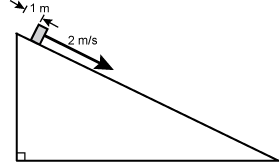
Which of the following tables gives the correct values for the speed of the object and the distance the object has traveled from its starting point at the given times?
- Answer
-
Correct Response: C.
This question requires the examinee to analyze motion in terms of concepts of displacement, velocity, and acceleration. Since the inclined plane is frictionless, the object will slide down the plane with constant acceleration due to the component of the gravitational force in the direction of the inclined pane. A characteristic of constant acceleration is that the speed of the particle will increase at a constant rate with respect to time, but the distance the object travels depends on the square of the time elapsed, d = . In
response C, the speed at one second intervals is given by 0, 2, 4, 6, 8, which is
increasing at a constant rate with respect to time while the distance traveled is
given by 0, 1, 4, 9, 16, which depends on the square to the time, t.
. In
response C, the speed at one second intervals is given by 0, 2, 4, 6, 8, which is
increasing at a constant rate with respect to time while the distance traveled is
given by 0, 1, 4, 9, 16, which depends on the square to the time, t.
Competency 0008
Understand the characteristics and properties of mechanical and electromagnetic
waves.
Students measure the frequency of the waves generated in a microwave oven using the following procedure. They place a large dish covered with a thin layer of chocolate fudge inside the microwave oven and turn on the oven for about 40 seconds, making certain that the dish does not rotate. When they remove the dish, they observe several melted spots on the fudge, as shown in the diagram below. The students measure the distance, d, between corresponding melted spots and find the average to be about d = 6.0 cm.
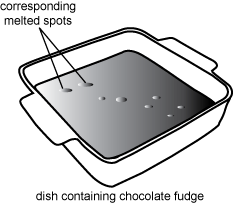
The students next argue that the distance between the corresponding melted spots represents one-half the wavelength of the microwaves and use the formula c = f λ, with λ = 2d = 12.0 cm and c the speed of a microwave, to solve for f, the frequency of the waves.
Which of the following best justifies the assumption that λ = 2d?
- d represents the average value of the microwave amplitudes.
- d represents the distance between a crest and a trough of a standing wave.
- d represents the angle of refraction of the microwaves passing through the fudge.
- d represents the average speed of the waves times the wave period.
- Answer
-
Correct Response: B.
This question requires the examinee to analyze the properties of waves (e.g., speed, frequency, wavelength). A microwave oven generates electromagnetic waves. Electromagnetic waves, like all waves, obey the superposition principle, which states that two or more electromagnetic waves can be combined together to create a resultant wave. The waves may add (if they are in phase) or subtract (if they are out of phase). Microwave ovens are designed so that the electromagnetic waves confined in the space inside the microwave oven reflect off the walls and recombine in such a way as to produce a standing wave (also called a stationary wave). This phenomenon is identical to that of a wave on a plucked string that is fixed at both ends, such as on a guitar string. The diagram below represents the nodes and antinodes of a standing electromagnetic wave. The nodes of a standing wave are where the reflected waves subtract and the wave amplitude is zero. The antinodes are where the reflected waves add together to create a maximum amplitude. At the antinodes, the electric field associated with the wave will transmit the maximum amount of energy to the water molecules in the fudge, causing them to gain molecular motion and increase in temperature, melting the fudge. Therefore, if the melted regions are formed by the antinodes of the standing waves, then they correspond to the crest and trough of a standing wave. As can be seen in the diagram, if L represents the wavelength of the standing wave, then the distance between the melted regions should be one-half of the wavelength, or L = 2d, which justifies the assumption made by the students.
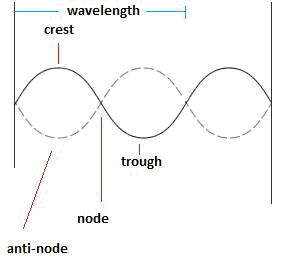
Competency 0009
Understand electricity and magnetism.
During the late nineteenth century, Thomas Edison developed a direct current system for generating and delivering electricity to homes and businesses. With the ideas of Nikola Tesla, George Westinghouse developed an alternating current system that had many advantages over Edison's direct current system. The advantages of an alternating current system ultimately led to its widespread adoption, and it is the system in use today. A major advantage of the alternating current system over the direct current system was that electricity could be:
- distributed more efficiently over power lines at very high voltages and then stepped down with a transformer for use in homes and businesses.
- generated from a single source for use in electrical systems that were wired either in series or in parallel.
- produced using hydroelectric generators, the dominant source of energy for electric power plants in the nineteenth century.
- used in homes and businesses safely without having to undergo a step-down in voltage at a transformer station.
- Answer
-
Correct Response: A.
This question requires the examinee to analyze the operation of series and parallel circuits and the relationship between electric current, voltage, and resistance described by Ohm's law. The power transmitted over a conducting wire is given by the product of the current and the voltage. Thus, the same power can be transmitted using either low current and high voltage, or high voltage and low current. The direct current electrical power distribution system developed by Edison used a relatively low voltage and a high current. Because all wires have electrical resistance, wires carrying current dissipate energy as heat. The greater the current in a wire, the more heat the wire will dissipate. Edison's high current system therefore resulted in high energy loss. This meant that power could not be transmitted over long distances and would require many more power plants located near people's homes. Tesla's alternating current system was able to use transformers to transmit power at a high voltage and low current, thereby reducing the heat generated due to the resistance of wire. Power could be transmitted over greater distances with less energy loss. The high voltage could then be converted, or "stepped down" to a fairly low voltage by transformers located near a residence or business.
Competency 0010
Understand the characteristics, organization, and processes of cells.
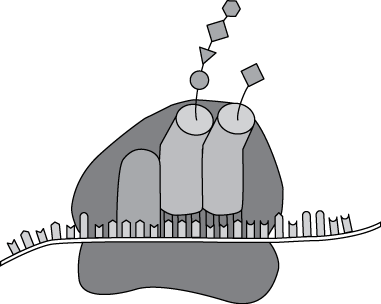
The ribosome shown in the diagram above is engaged in which of the following activities?
- assembling a protein from amino acids that are bound to tRNA
- breaking down proteins by hydrolysis to recycle their constituents within the cell
- transcribing DNA from a chromosome during mitosis
- transferring proteins to a transport vesicle for transport through the outer membrane
- Answer
-
Correct Response: A.
This question requires the examinee to analyze the structure and function of organelles in eukaryotic and prokaryotic cells. Ribosomes are cellular organelles located in the cytoplasm that are composed of ribosomal RNA and proteins. Ribosomes synthesize proteins by using messenger RNA as a sequencing template to organize transfer RNA molecules that are attached to specific amino acids. As the transfer RNA is sequenced by the ribosome, the attached amino acids are linked together to form a particular protein.
Competency 0011
Understand the classification and characteristics of organisms.
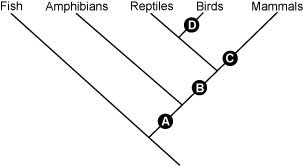
The cladogram above depicts the evolution of vertebrate animals. Which point on the cladogram corresponds to the appearance of the amniote egg?
- point A
- point B
- point C
- point D
- Answer
-
Correct Response: B.
This question requires the examinee to demonstrate knowledge of the diversity of life and the taxonomic relationships among living organisms. The first amniotic egg evolved approximately 340 million years ago in ancestral reptiles during the Carboniferous period. These early reptiles were descended from amphibians and the evolution of the amniotic egg allowed reptiles to expand into drier terrestrial habitats. Reptiles, birds, and mammals all have amniotic eggs that are separate from the body of the mother and that can manage gas exchange, waste storage, and effectively store and transfer nutrients to the growing embryo. In order for the amniotic egg to be present in reptiles, birds, and mammals, it must have evolved in an early ancestor of the reptile, indicated as letter B in the cladogram shown.
Competency 0012
Understand concepts and principles related to genetics and evolution.
Which of the following statements best explains why mass extinctions, such as those that occurred at the end of the Permian and the end of the Cretaceous, are often followed by major adaptive radiations of the lineages that remain?
- Events thought to cause mass extinctions, such as asteroid or comet strikes or large-scale volcanic eruptions, can lead to higher mutation rates and rapid evolutionary change in surviving lineages.
- Surviving lineages are usually well adapted to occupy the changed environments and ecological conditions that have been brought about by the events causing the extinctions.
- Populations of surviving lineages are generally small and isolated and are more affected by genetic drift, natural selection, and other forces that cause rapid speciation and diversification.
- The life-forms filling most ecological niches have disappeared and the surviving lineages adapt and diversify to occupy these unoccupied niches with minimal competition.
- Answer
-
Correct Response: D.
This question requires the examinee to demonstrate knowledge of major events in the history of life, mass extinctions, and the evolution of organisms, including humans. Mass extinctions, such as occurred at the end of the Permian and the end of the Cretaceous, are triggered by catastrophic changes in Earth environments that eradicate large numbers of species. This environmental upheaval and dramatic loss in biological diversity eventually opens up many new habitats. The availability of unoccupied ecological niches and the minimal competition within those ecosystems supports extensive diversification of the surviving taxonomic groups. Species that survive a mass extinction for whatever reason become the bank for biological radiations that fill newly emptied and newly created ecological niches.
Competency 0013
Understand characteristics of different biomes, relationships among organisms, and
the flow of matter and energy through ecosystems.
The ecosystem around deep-ocean hydrothermal vents includes giant tube worms, several species of crustaceans, and a variety of other organisms. The primary source of nutrients and energy supporting this ecosystem is:
- bodies of dead phytoplankton and other organisms that continuously rain down from surface.
- mats of blue-green algae that colonize rocks surrounding the vents.
- zooplankton that move to the surface at night and back down to the vents during the day.
- bacteria that oxidize sulfur present in the outflow from the vents.
- Answer
-
Correct Response: D.
This question requires the examinee to recognize strategies used by different organisms to obtain the basic needs for life. Although most life on Earth depends on sunlight, benthic organisms living in the lightless deep ocean rely on material that rains down into the benthos from higher in the water column. This light rain of organic debris, however, can only support extremely sparse populations of organisms on the deep-ocean floor. The extensive and dense biological communities found near deep-ocean hydrothermal vents are supported instead by chemosynthetic autotrophic bacteria. The primary productivity of these chemosynthetic bacteria is based on the energy the bacteria derive from the oxidation of sulfur compounds in the mineral-rich water that flows from deep-sea hydrothermal vents and not from energy from the sun.
Competency 0014
Understand physical geology and the history of Earth.
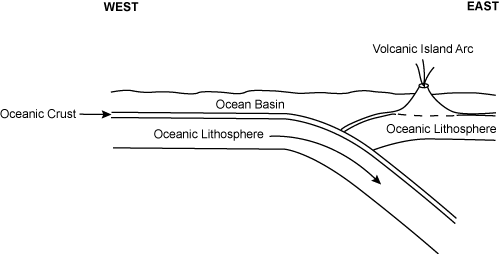
The diagram above shows one oceanic tectonic plate being subducted beneath another. Over time, a volcanic island arc forms east of the of the subduction zone. Which of the following is the underlying process primarily responsible for the formation of the volcanic island arc?
- Water released from the subducting plate lowers the melting temperature of some of the mantle, forming plumes of magma that rise toward the surface.
- Plumes of molten material from the core-mantle boundary are forced upward by convection currents produced by the descending plate.
- Intense pressure generates heat that melts the subducting plate and the sediments it carries, producing molten material that flows upward into magma chambers.
- Frictional heating completely melts the descending plate by the time it reaches the lower mantle producing buoyant magma plumes.
- Answer
-
Correct Response: A.
This question requires the examinee to analyze tectonic processes, the mechanisms driving plate movements, and the landforms and geologic phenomena produced by movement at plate boundaries. A major factor controlling the temperature at which rock melts is the water content in the rock. As an oceanic plate descends into the mantle beneath another tectonic plate, water and other volatiles in the ocean crust are driven off by the increasing heat and pressure. The water moves upward into the overlying mantle rock, lowering the melting temperature enough to produce some magma. This magma then rises toward the surface, ultimately forming a string of islands that parallel the subduction zone known as an island arc.
Competency 0015
Understand characteristics of the hydrosphere, weather, and climate.
At a certain height in the atmosphere, a rising parcel of air reaches its dew point and becomes saturated, leading to cloud formation. Which of the following best describes what occurs at the molecular level during this process?
- The rising parcel of air carries dust and other condensation nuclei into the upper troposphere, where the high concentration of water vapor supports cloud formation.
- The rising parcel of air mixes with its surroundings, increasing turbulence and the speed at which individual water molecules collide, causing them to merge into water droplets that attract condensation nuclei.
- The rising parcel of air cools and contracts in the upper troposphere, forcing water molecules into closer and closer contact until they collide and form clouds.
- The rising parcel of air cools, slowing the motion of water molecules and increasing the likelihood that individual water molecules that collide will stick together on condensation nuclei and form water droplets.
- Answer
-
Correct Response: D.
This question requires the examinee to analyze the physical processes driving the hydrologic cycle (e.g., solar heating, evaporation, condensation). Rising air expands because atmospheric pressure decreases with height. The kinetic theory of gases states that gases are composed of many small particles in a state of constant random motion and that these particles are constantly colliding with each other. With increasing space between the particles in the expanding parcel of air, the average velocity of the particles drops. Since the average velocity of particles in a gas is a measure of the temperature of the air parcel, a drop in average particle velocity means a drop in temperature. Molecules of gaseous water in the air also move more slowly in cooler air and as these water molecules in the gas phase collide, some stick together. The cooler the air mass, the greater the number of water molecules that stick together after a collision. Condensation nuclei in the atmosphere support this process because water vapor molecules in a cooling air mass generally need a surface on which to condense. When a rising air parcel reaches the dew point as it becomes saturated, water vapor condenses on these particles to produce large water droplets that are visible as clouds.
Competency 0016
Understand characteristics of the solar system and universe.
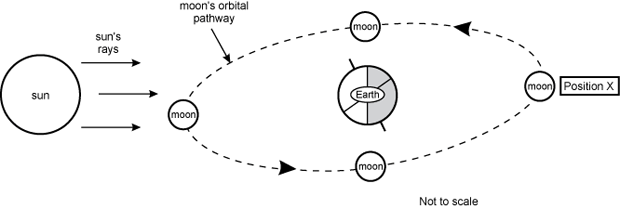
At approximately which time of day will the moon rise when it is at position X in the diagram above?
- sunrise
- noon
- sunset
- midnight
- Answer
-
Correct Response: C.
This question requires the examinee to analyze the interactions of the sun, the moon, and Earth and the effects of these interactions on Earth systems. During the lunar cycle, position X in the diagram is the position that the moon occupies when it is full. The moon during this phase is on the side of Earth facing away from the sun (i.e., the night-time side of Earth), therefore it is only visible between sunset and sunrise. Conversely, when the moon is between the sun and Earth, it is a new moon that is faintly visible rising at sunrise and setting at sunset.



